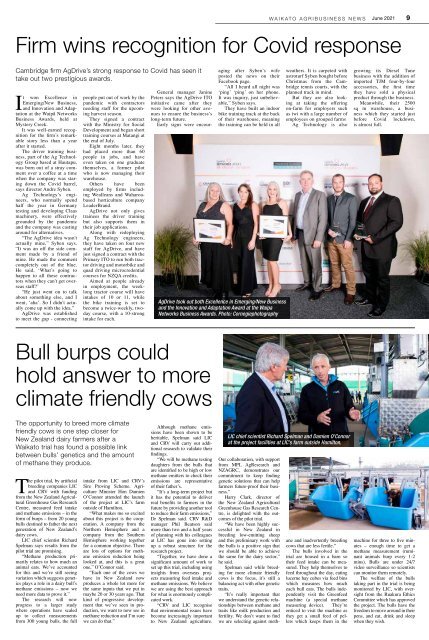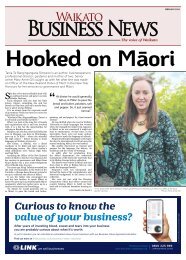Waikato AgriBusiness News June 2021
The publication profiling the best in agribusiness in Waikato. NZ businesses are helping Waikato farmers thrive through research, development and innovation – from identifying farmers’ needs to designing, developing and commercialising unique solutions to help them.
The publication profiling the best in agribusiness in Waikato. NZ businesses are helping Waikato farmers thrive through research, development and innovation – from identifying farmers’ needs to designing, developing and commercialising unique solutions to help them.
- No tags were found...
Create successful ePaper yourself
Turn your PDF publications into a flip-book with our unique Google optimized e-Paper software.
WAIKATO AGRIBUSINESS NEWS <strong>June</strong> <strong>2021</strong><br />
9<br />
Firm wins recognition for Covid response<br />
Cambridge firm AgDrive’s strong response to Covid has seen it<br />
take out two prestigious awards.<br />
It won Excellence in<br />
Emerging/New Business,<br />
and Innovation and Adaptation<br />
at the Waipā Networks<br />
Business Awards, held at<br />
Mystery Creek.<br />
It was well-earned recognition<br />
for the firm’s remarkable<br />
story less than a year<br />
after it started.<br />
The driver training business,<br />
part of the Ag Technology<br />
Group based at Hautapu,<br />
was born out of a stray comment<br />
over a coffee at a time<br />
when the company was staring<br />
down the Covid barrel,<br />
says director Andre Syben.<br />
Ag Technology’s engineers,<br />
who normally spend<br />
half the year in Germany<br />
testing and developing Claas<br />
machinery, were effectively<br />
grounded by the pandemic<br />
and the company was casting<br />
around for alternatives.<br />
“The AgDrive idea wasn't<br />
actually mine,” Syben says.<br />
“It was an off the side comment<br />
made by a friend of<br />
mine. He made the comment<br />
completely out of the blue.<br />
He said, ‘What’s going to<br />
happen to all these contractors<br />
when they can't get overseas<br />
staff?’<br />
“He just went on to talk<br />
about something else, and I<br />
went, ‘aha’. So I didn't actually<br />
come up with the idea.”<br />
AgDrive was established<br />
to meet the gap - connecting<br />
people put out of work by the<br />
pandemic with contractors<br />
needing staff for the upcoming<br />
harvest season.<br />
They signed a contract<br />
with the Ministry for Social<br />
Development and began short<br />
training courses at Matangi at<br />
the end of July.<br />
Eight months later, they<br />
had placed more than 60<br />
people in jobs, and have<br />
even taken on one graduate<br />
themselves, a former pilot<br />
who is now managing their<br />
warehouse.<br />
Others have been<br />
employed by firms including<br />
Wealleans and Waharoabased<br />
horticulture company<br />
LeaderBrand.<br />
AgDrive not only gives<br />
trainees the driver training<br />
but also supports them in<br />
their job applications.<br />
Along with redeploying<br />
Ag Technology engineers,<br />
they have taken on four new<br />
staff for AgDrive, and have<br />
just signed a contract with the<br />
Primary ITO to run both tractor<br />
driving and motorbike and<br />
quad driving microcredential<br />
courses for NZQA credits.<br />
Aimed at people already<br />
in employment, the weeklong<br />
tractor course will have<br />
intakes of 10 or 11, while<br />
the bike training is set to<br />
become a twice-weekly, twoday<br />
course, with a 10-strong<br />
intake for each.<br />
General manager Janine<br />
Peters says the AgDrive ITO<br />
initiative came after they<br />
were looking for other avenues<br />
to ensure the business’s<br />
long-term future.<br />
Early signs were encouraging<br />
after Syben’s wife<br />
posted the news on their<br />
Facebook page.<br />
“All I heard all night was<br />
‘ping’ ‘ping’ on her phone.<br />
It was inquiry, just unbelievable,”<br />
Syben says.<br />
They have built an indoor<br />
bike training track at the back<br />
of their warehouse, meaning<br />
the training can be held in all<br />
AgDrive took out both Excellence in Emerging/New Business<br />
and the Innovation and Adaptation Award at the Waipa<br />
Networks Business Awards. Photo: Cornegiephotography<br />
weathers. It is carpeted with<br />
astroturf Syben bought before<br />
Christmas from the Cambridge<br />
tennis courts, with the<br />
planned track in mind.<br />
But they are also looking<br />
at taking the offering<br />
on-farm for employers such<br />
as iwi with a large number of<br />
employees on grouped farms<br />
Ag Technology is also<br />
growing its Diesel Tune<br />
business with the addition of<br />
imported TJM four-by-four<br />
accessories, the first time<br />
they have sold a physical<br />
product through the business.<br />
Meanwhile, their 2500<br />
sq m warehouse, a business<br />
which they started just<br />
before Covid lockdown,<br />
is almost full.<br />
Bull burps could<br />
hold answer to more<br />
climate friendly cows<br />
The opportunity to breed more climate<br />
friendly cows is one step closer for<br />
New Zealand dairy farmers after a<br />
<strong>Waikato</strong> trial has found a possible link<br />
between bulls’ genetics and the amount<br />
of methane they produce.<br />
The pilot trial, by artificial<br />
breeding companies LIC<br />
and CRV with funding<br />
from the New Zealand Agricultural<br />
Greenhouse Gas Research<br />
Centre, measured feed intake<br />
and methane emissions – in the<br />
form of burps – from 20 young<br />
bulls destined to father the next<br />
generation of New Zealand’s<br />
dairy cows.<br />
LIC chief scientist Richard<br />
Spelman says results from the<br />
pilot trial are promising.<br />
“Methane production primarily<br />
relates to how much an<br />
animal eats. We’ve accounted<br />
for this and we’re still seeing<br />
variation which suggests genetics<br />
plays a role in a dairy bull’s<br />
methane emissions – now we<br />
need more data to prove it.”<br />
The research will now<br />
progress to a larger study<br />
where operations have scaled<br />
up to collect measurements<br />
from 300 young bulls, the full<br />
intake from LIC and CRV’s<br />
Sire Proving Scheme. Agriculture<br />
Minister Hon Damien<br />
O’Connor attended the launch<br />
of the project at LIC’s farm<br />
outside of Hamilton.<br />
“What makes me so excited<br />
about this project is the cooperation.<br />
A company from the<br />
Northern Hemisphere and a<br />
company from the Southern<br />
Hemisphere working together<br />
for a common objective. There<br />
are lots of options for methane<br />
emission reduction being<br />
looked at, and this is a great<br />
one,” O’Connor said.<br />
“Each one of the cows we<br />
have in New Zealand now<br />
produces a whole lot more for<br />
the same inputs that we put in<br />
maybe 20 or 30 years ago. That<br />
kind of progressive development<br />
that we’ve seen in production,<br />
we want to now see in<br />
methane reduction and I’m sure<br />
we can do that.”<br />
Although methane emissions<br />
have been shown to be<br />
heritable, Spelman said LIC<br />
and CRV will carry out additional<br />
research to validate their<br />
findings.<br />
“We will be methane testing<br />
daughters from the bulls that<br />
are identified to be high or low<br />
methane emitters to check their<br />
emissions are representative<br />
of their father’s.<br />
“It’s a long-term project but<br />
it has the potential to deliver<br />
real benefits to farmers in the<br />
future by providing another tool<br />
to reduce their farm emissions,”<br />
Dr Spelman said. CRV R&D<br />
manager Phil Beatson said<br />
more than two and a half years<br />
of planning with his colleagues<br />
at LIC has gone into setting<br />
up a robust structure for the<br />
research project.<br />
“Together, we have done a<br />
significant amount of work to<br />
set up this trial, including using<br />
insights from overseas projects<br />
measuring feed intake and<br />
methane emissions. We believe<br />
we are using the best approach<br />
for what is enormously complicated<br />
work.<br />
“CRV and LIC recognise<br />
that environmental issues have<br />
become increasingly important<br />
to New Zealand agriculture.<br />
LIC chief scientist Richard Spelman and Damien O’Connor<br />
at the project facilities at LIC’s farm outside Hamilton.<br />
Our collaboration, with support<br />
from MPI, AgResearch and<br />
NZAGRC, demonstrates our<br />
commitment to keep finding<br />
genetic solutions that can help<br />
farmers future-proof their business.”<br />
Harry Clark, director of<br />
the New Zealand Agricultural<br />
Greenhouse Gas Research Centre,<br />
is delighted with the outcomes<br />
of the pilot trial.<br />
“We have been highly successful<br />
in New Zealand in<br />
breeding low-emitting sheep<br />
and this preliminary work with<br />
the bulls is a positive sign that<br />
we should be able to achieve<br />
the same for the dairy sector,”<br />
he said.<br />
Spelman said while breeding<br />
for more climate friendly<br />
cows is the focus, it’s still a<br />
balancing act with other genetic<br />
traits.<br />
“It’s really important that<br />
we understand the genetic relationships<br />
between methane and<br />
traits like milk production and<br />
fertility. We don’t want to find<br />
we are selecting against methane<br />
and inadvertently breeding<br />
cows that are less fertile.”<br />
The bulls involved in the<br />
trial are housed in a barn so<br />
their feed intake can be measured.<br />
They help themselves to<br />
feed throughout the day, eating<br />
lucerne hay cubes via feed bins<br />
which measures how much<br />
each bull eats. The bulls independently<br />
visit the Greenfeed<br />
machine (a special methane<br />
measuring device). They’re<br />
enticed to visit the machine as<br />
they get a small feed of pellets<br />
which keeps them in the<br />
machine for three to five minutes<br />
– enough time to get a<br />
methane measurement (ruminant<br />
animals burp every 1-2<br />
mins). Bulls are under 24/7<br />
video surveillance so scientists<br />
can monitor them remotely.<br />
The welfare of the bulls<br />
taking part in the trial is being<br />
monitored by LIC, with oversight<br />
from the Ruakura Ethics<br />
Committee which has approved<br />
the project. The bulls have the<br />
freedom to move around in their<br />
pens, and eat, drink and sleep<br />
when they wish.


















